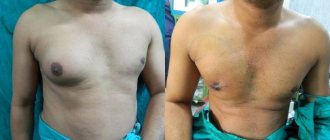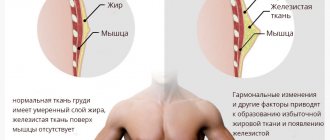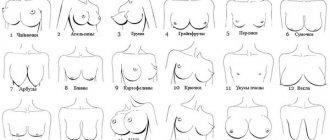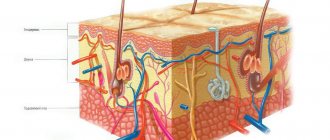Description and reasons
Women are used to being upset if they have small breasts, but there are cases when large breasts can weigh several kilograms, which causes considerable difficulties.
Hypermastia in women occurs mainly in adolescence and after 30 years. Gynecomastia occurs in a rare form in men. It manifests itself as an increase in glands and adipose tissue, which is why the breasts become similar to those of a woman. The pathology is caused by a violation of the ratio of the hormone testosterone or disease of the adrenal glands. Requires immediate medical attention and treatment.
Macromastia is associated with a sharp increase in fat and connective tissue over a period of 6-8 months. Reasons for the development of pathology:
- hormonal imbalances during puberty, during pregnancy and lactation;
- endocrine diseases leading to metabolic failures;
- overweight;
- injuries and previous surgeries.
Hypermastia causes not only physical, but also psychological inconvenience. Heaviness and pressure on the chest are felt, posture is disturbed, and scoliosis forms. Characteristic symptoms: shortness of breath, stretch marks and irritation in the skin folds.
To understand how to reduce large breasts and relieve discomfort, you need to consult a doctor. He will conduct a diagnosis and prescribe a correction. For the puberty period, therapy with a course of hormones is possible. For other situations, surgical correction of large breasts is effective.
How to solve a problem
Gigantomastia is a congenital genetic pathology in which the mammary glands lose their shape and grow to incredible sizes. The process can start at any age, due to any imbalance in the body.
Types of gigantomastia
| Puberty | Glandular tissue grows during puberty |
| Postpartum | Adipose tissue increases due to a malfunction in lipid metabolism. Additional complications may arise due to uncontrolled weight gain. |
| Double sided | Bilateral gigantomastia is expressed on both mammary glands |
| One-sided | The manifestation is noticeable only on one side |
The only way to eliminate the problem is reduction mammoplasty (breast reduction). With the help of plastic surgery, women can experience physical relief and psychological balance for the first time.
Additional problems with gigantomastia in women
Chest pain gradually intensifies, causing pain in the neck, back and shoulders- If medical recommendations are not followed, mastitis and mastopathy develop
- Feeling of chest tightness
- The appearance of skin stretch marks
- Disorders of the menstrual cycle
- Constant tension of the glands themselves
- Pathological discharge from the nipples
Contraindications for surgery
- Acute and chronic infectious diseases in the stage of decompensation
- Minor age
- Heart defects
- HIV AIDS
Important. Gigantomastia in girls can develop at a rapid pace, but even with the written consent of the parents, the operation is prohibited; it is necessary to wait until adulthood.
Indications for surgical intervention
Breast macromastia causes a lot of inconvenience: it is impossible to play sports, sleep on the stomach, it is difficult to cover long distances, choose clothes, and regular pain is a concern due to the load on the spine. The main indication for reduction mammoplasty is physiological and psycho-emotional discomfort. A huge bust not only disrupts your comfortable lifestyle, it also affects how you perceive and accept yourself. May lead to depression and poor health.
There are a number of reasons why plastic surgery cannot be performed:
- oncological and other pathological diseases;
- period of pregnancy and lactation;
- skin diseases and other abnormalities in the breast area;
- poor blood clotting.
An experienced doctor will diagnose, determine the risks and tell you what to do if your breasts are too large.
Surgical treatment of macromastia
Macromastia is a pathology that is difficult to treat, since the process must be monitored by several specialists, including a gynecologist, mammologist, endocrinologist and oncologist. In most cases, the surgeon has the final say.
Unfortunately, the most effective method of treatment, especially in cases of aggressive macromastia, remains mastectomy (removal) of the mammary glands - an operation that patients agreed to with great reluctance just a few years ago . Today the situation has changed - the possibility of breast prosthetics has become possible during resection or after some time . Modern techniques make it possible to restore breast volume, and the woman retains her external attractiveness and positive attitude.
According to indications, reduction mammoplasty is used - an operation aimed not at complete removal, but at reducing the volume of the mammary gland . Such an operation involves taking antiestrogens, and in most cases, without drug support, surgical intervention does not make sense. Experience shows that reduction mammoplasty does not eliminate macromastia forever; the pathology can develop again when hormonal levels change.
Reduction mammoplasty
Macromastia is treated surgically. During the operation, excess glandular and fatty layers are removed, reducing the volume to an acceptable size. They also slightly correct the shape of the breast and tighten stretched skin. Reduction mammoplasty is performed under general anesthesia and takes from 1.5 to 4 hours. The rehabilitation period lasts up to six months, during which time you should strictly adhere to the doctor’s recommendations:
- reduce physical activity;
- Healthy food;
- wear compression garments;
- do not overcool and do not overheat.
Drug treatment of macromastia
It is impossible to completely recover from the proliferation of mammary gland tissue with the help of medications; it is possible to only slightly restrain the process. For such purposes, the drugs Norethindrone and Parlodel are used , however, after stopping the use, the breasts begin to grow again - only surgical intervention will stop the process.
According to experts, for macromastia, taking the synthetic anti-estrogen Tamoxifen is indicated, which suppresses estrogens in the mammary glands. In most cases, experts recommend taking this drug for three months after surgery to prevent relapse of the disease. Tamoxifen can be used in the early stages of macromastia to restore the reproductive system, as well as eliminate the woman’s gynecological diseases and problems with the thyroid gland.
Stages and degrees
Gigantomastia in women (photos of pathological lesions and the boundaries of their distribution will help obtain instrumental examination methods) also varies in severity. In this situation, the classifying feature is the volume of the mammary glands. The larger the breast, the more advanced the disease.
| Size | Description |
| 0-2 | The volume is 250-300 ml. The condition of the mammary glands is satisfactory. |
| 3-4 | We are talking about a mild form of hypertrophy of glandular tissue, the volume of which in this situation reaches 600 ml. |
| <6 | Average degree of hypertrophy of the mammary glands. The volume is 800 ml. |
| <8 | Severe degree of hypertrophy, characterized by a volume of 1200 ml. |
| 8 and above | At this stage, a diagnosis of gigantomastia is made. The volume of glandular tissue is 1200 ml or more. |
The described classification shows that women with breast size 3 and above are already in the risk category. Any negative provoking factor can cause the development of pathological processes. Therefore, it is important to visit a gynecologist or mammologist for preventive purposes in order to promptly detect the disease.
Possible consequences and complications
Gigantomastia in women (photos of the mammary glands at an early stage of the disease will make you think and go to the hospital for diagnosis) does not always bring pleasure and attention from the male half of humanity.
If the cause of rapid breast enlargement is a pathological factor, it is necessary to undergo comprehensive diagnostics and treatment. Otherwise, the woman will face unpleasant consequences. This is not only difficulties with choosing underwear or excessive attention from men.
Large breasts will negatively affect a woman's health. All spinal sections will be under heavy load. A complication is a gradual deterioration of posture. The pain will become chronic. Bra straps cut into the body and cause severe discomfort.
Physical activity and any activities with large breasts are impossible. It cannot be fixed to avoid painful and uncomfortable movement when running, jumping or bending.
From sweat, diaper rash will appear on the body, which without proper personal hygiene will turn into wounds. Large breasts will become an obstacle to the diagnosis of tumor tumors.
It will be difficult for the doctor to detect the lump during palpation. This is especially important in cases where there is a risk of degeneration of the affected tissues, resulting in malignant processes. Therefore, timely diagnosis and surgery will help avoid unpleasant consequences.
It is easier to prevent gigantomastia in a woman than to fight it, especially at an advanced stage. There is always a possibility of serious complications, which can be seen in photos on the Internet.
And simple advice from a doctor will help prevent the disease. It is enough for women to lead a healthy and active lifestyle. If there is a risk or a hereditary predisposition, for preventive purposes, visit a specialist and undergo an examination.
Factors affecting breast development
Active breast growth occurs at 13-15 years of age, and it acquires adult shape only at 16-17 years of age. The final size of the mammary glands in women is determined only after the lactation period. Breast development depends on many factors. First of all, the size and shape of the breast depend on genetic factors. The second thing that influences breast formation is hormones.
Estrogen is the main hormone that influences breast growth, although this does not mean that increasing its levels in the body will result in larger breasts. It plays an important role in the formation of ducts and connective fibers. When there is an excess amount of estrogen in the body, a protective function is activated, which consists of closing the receptor sites responsible for the appearance of new cells. As a result, breast growth stops.
Xenoestrogens, organohalogens that are structurally similar to estrogens, have a negative effect on the breast. They are in the external environment due to industrial activities. When they enter the body, they destroy the connections necessary for the normal functioning of the endocrine system.
Side hormones found in meat and entering the body through the gastrointestinal tract also have a similar effect. The body of all animals contains estrogen and testosterone, which, when consumed in excess, inhibit the formation of mammary glands.
Prolactin, a hormone produced by the pituitary gland, has a positive effect on breast formation. This hormone increases the number of estrogen-sensitive receptors in the mammary gland and accelerates breast growth. Its level increases greatly during puberty and pregnancy.
Testosterone greatly inhibits breast growth. When you eat a lot of foods high in sugar, the body begins to produce insulin to lower glucose levels, which leads to an increase in testosterone levels in the blood. With a large amount of insulin, DHT is formed - this is testosterone in a more active form, which has a much greater effect on the receptors. With excess DHT, growth arrest and even breast atrophy can occur.
Beautiful breasts grow only with normal hormonal levels.
Breast growth is also influenced by the monthly cycle. The formation of the mammary glands ends 1-2 years after the menstrual cycle has stabilized.
In addition, the amount of fatty tissue in the body affects breast size. When gaining 1 kg of fat, the mammary glands increase by 20 g.
Hypermastia: rehabilitation measures
After breast reduction, the patient is under the supervision of doctors for 1-2 days. This period is sufficient for all early postoperative symptoms to subside. On the third day, the drains are removed and the woman goes home.
At first, there is great pain and swelling, a feeling of chest fullness. This is understandable, because incisions are made, and the body reacts to the intervention. Squeezing and discomfort are associated with wearing compression garments, but you can’t do without them, because they help fix the results. At first you will have to sleep on your back and refrain from sexual contact.
After 1-2 weeks, the sutures are removed, and a special patch is glued in their place, which will speed up scarring. The incisions may be red for a long time, but over time they begin to fade and become less noticeable. But, as practice shows, for many women, the visibility of scars is better than large breasts and the problems associated with them.










